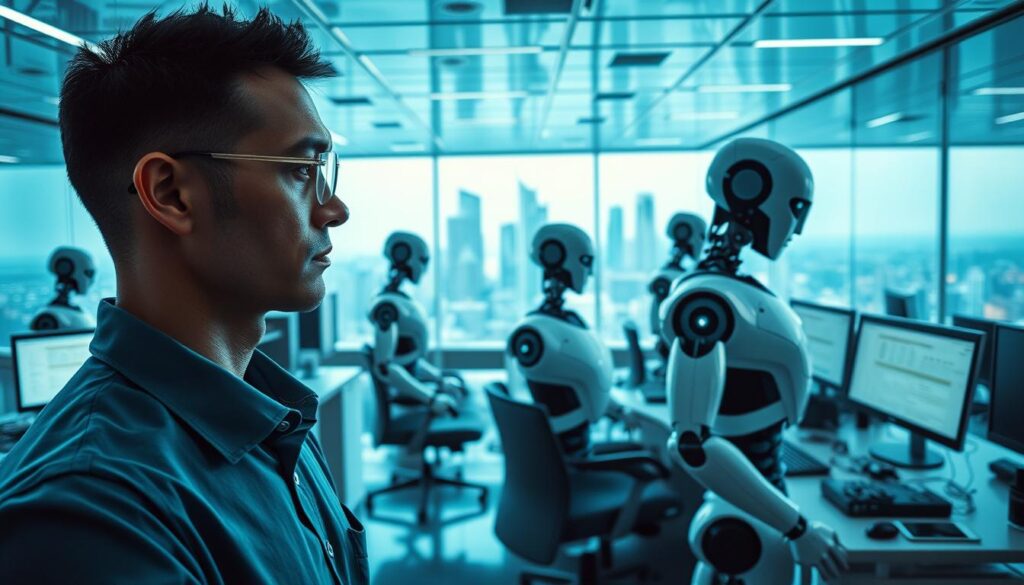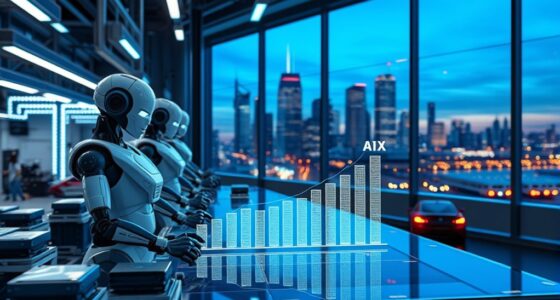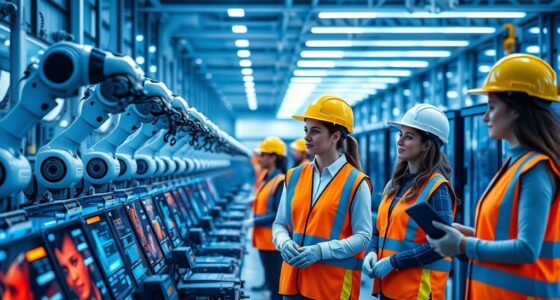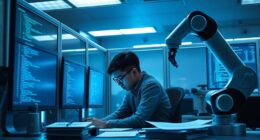Did you know that according to a recent report by McKinsey, up to 30% of the workforce could be displaced by automation in the next decade? This staggering statistic underscores the urgency for white-collar professionals to understand the profound AI job impact that is transforming industries worldwide. As artificial intelligence continues to evolve, the automated workforce is not just a futuristic concept but a current reality that shapes various sectors.
In this guide, you will learn vital career adaptation strategies to navigate the impending changes in the workplace effectively. Understanding the nuances of how AI affects your industry will empower you to take a proactive stance in securing your professional future. Prepare to explore essential insights tailored for anyone looking to thrive amid the shifts caused by advancing technology.
Key Takeaways
- 30% of jobs could be affected by automation over the next decade.
- Adapting to the automated workforce is essential for job security.
- Understanding AI job impact can help you better prepare for changes.
- Career adaptation strategies will be vital for your professional growth.
- Proactive learning will enhance your employability in a changing market.
The Rise of AI in the Workplace
The rise of AI is reshaping the workplace landscape as companies across various industries adopt advanced technologies. From enhancing productivity to streamlining operations, the impact of AI in business is profound. Workplace automation plays a crucial role in transforming traditional job functions, offering insights into data analysis and process efficiency that were previously unattainable.
As organizations embrace technology transformation, they find new ways to balance human expertise with artificial intelligence capabilities. Employees may face challenges as their roles evolve, yet the potential benefits of AI can lead to improved decision-making processes and broader opportunities for innovation.
Workplace automation not only reduces operational costs but also allows teams to focus on more strategic initiatives. Employees who adapt to these changes can find themselves in positions that encourage creativity and critical thinking, underscoring the vital role of human judgment in an increasingly automated environment.

Understanding the Impact of AI on White Collar Jobs
The impact of AI on jobs extends far beyond simple automation tasks. As AI continues to advance, its influence on white collar employment changes dramatically, reshaping the nature of work and the skills required. Traditional roles that involved repetitive tasks face significant risk of job displacement as machines take over these responsibilities.
This evolution does not solely signify loss; it also presents opportunities for new job creation. Workers must adapt to these changes by acquiring new skills tailored to AI technology. Emphasizing critical thinking, creativity, and emotional intelligence will play a crucial role in navigating the modern job landscape.
Organizations can also benefit by optimizing workflows through AI. As industries embrace this technology, a shift in the labor market will occur, necessitating a reassessment of career trajectories for many professionals. Understanding the nuances of these shifts is vital for you to remain competitive and resilient in an evolving workforce.

| Aspect | Details |
|---|---|
| Job Displacement Risk | Roles with high repetition face the highest risk of automation. |
| New Skill Requirements | Demand for skills in AI technology and data analysis increases. |
| Workforce Adaptability | Professionals must adapt by improving soft skills and technical knowledge. |
| Industry Transformation | Changes in job roles prompt a reevaluation of hiring practices. |
AI Taking Over – A White Collar Job Bloodbath
The advent of artificial intelligence is reshaping the landscape of white collar employment. You may wonder about the implications for various roles within your organization. Certain positions that involve repetitive tasks and extensive data manipulation are particularly vulnerable to automation, giving rise to valid concerns regarding job security.
The Vulnerable Roles: Who’s Most at Risk?
Positions such as administrative assistants, clerks, and customer service representatives fall under the category of vulnerable job roles. These roles often require handling standard procedures that AI technology can replicate, leading to significant disruption in employment. Alongside this, sectors like public administration and finance are at high risk, as technological advancements streamline many processes, reducing the need for human intervention.
Statistical Predictions for Job Losses in the Coming Years
Job loss predictions related to AI integration present a sobering outlook for the workforce. Studies indicate that nearly 30% of current jobs could be affected by automation by 2030. This staggering figure underscores the urgency for workers to adapt. AI risk factors include not only job replacement but also the potential stagnation of wage growth in fields prone to automation. Below is a breakdown of the anticipated job losses across various industries:
| Industry | Percentage of Workforce at Risk | Estimated Job Losses by 2030 |
|---|---|---|
| Public Administration | 25% | 600,000 |
| Finance | 23% | 500,000 |
| Customer Service | 40% | 1,200,000 |
| Healthcare Administration | 30% | 300,000 |

Key Industries Affected by AI Transformation
The landscape of several key industries is shifting due to AI transformation industries. Understanding the specific impacts reveals how various sectors are adapting to stay relevant. Each industry faces unique automation impact sectors, as the introduction of advanced technologies alters traditional practices. The following sections highlight the significant changes within different fields.
The Public Sector: A Bureaucratic Shake-up
The public sector is undergoing a profound transformation driven by AI. Automation is streamlining operations, leading to faster processing times for services and a reduction in paperwork. This shift promotes efficiency but raises concerns about job security. Employees may need to adapt to new roles that focus on oversight and strategy rather than routine tasks.
Finance and Insurance: Automation in Action
In the finance and insurance industries, AI integration is enhancing efficiency and accuracy. Tasks such as data analysis, risk assessment, and customer interactions are increasingly managed by intelligent systems. These industry-specific AI effects allow firms to deliver quicker services and tailor their offerings more closely to client needs. While this creates opportunities, it may also disrupt workforce dynamics.
Legal Professions: The Future of Law Firms
The legal profession is on the brink of significant changes due to AI’s capabilities. Law firms are adopting AI-driven tools for document review and legal research, greatly increasing efficiency. As the industry progresses, professionals may find that traditional legal practices evolve, pushing them to focus on more complex cases that require human judgment and expertise.

Women and Young Workers: The Most Impacted Groups
The integration of AI into the workforce brings significant challenges to numerous demographics, particularly women and young workers. Women hold a considerable share of administrative positions, which often face automation advancements. As a result, the gender and AI job impact shows that women may experience higher rates of job displacement compared to their male counterparts.
At the same time, young workers encounter various employment challenges. With entry-level positions shrinking due to automation, these individuals struggle to find a foothold in the job market. Traditional pathways that once provided opportunities for young talent are narrowing, contributing to the young workers employment challenges and impacting overall job prospects.
These shifts highlight the precarious situation for various groups within the workforce. Vulnerable demographics, including women and young individuals, stand at the forefront of these changes. Their experiences provide critical insights into the transforming landscape of employment influenced by technology.

Developing Skills for the AI Age
As the workplace evolves due to technological advancements, focusing on AI skills development becomes crucial. You must identify and cultivate essential skills for work to remain competitive in an automated environment. Workers who can adapt to change and enhance their capabilities will maintain relevance and drive career growth strategies.
Essential Skills for Thriving in an Automated Environment
To navigate the challenges posed by AI and automation, several key skills should be prioritized:
- Critical Thinking: The ability to analyze information effectively will be vital.
- Advanced Communication: Strong verbal and written communication skills enhance collaboration in diverse teams.
- Technical Know-How: Familiarity with new technologies and tools is essential for increasing your productivity.
Lifelong Learning: Strategies for Continuous Growth
A commitment to lifelong learning is necessary in the AI age. Consider the following strategies to ensure ongoing development:
- Engage in online courses that focus on emerging technologies and methodologies.
- Participate in workshops and webinars to build networks and share insights.
- Seek mentorship from professionals within your field to gain personalized guidance.

The Importance of Adaptability
In today’s fast-paced job market, adaptability in the workplace has become a cornerstone for success. As organizations continue to innovate and evolve, individuals must cultivate the ability to manage change effectively. Embrace change strategies that focus on flexibility and a willingness to learn from new experiences. This approach not only helps in adjusting to shifts in technology but also fosters a resilient mindset that can navigate various challenges.
How to Embrace Change as a Worker
Embracing change requires a proactive attitude. Begin by recognizing the benefits that come with professional flexibility. Adopting a growth mindset will encourage you to seek opportunities for personal and career development. Engage in training sessions, workshops, or online courses to enhance your skill set. Viewing challenges as learning experiences rather than obstacles can transform your perspective on change.
Strategies to Stay Ahead of the Curve
Deploying effective strategies can bolster your adaptability in the workplace. Start by building a network of professionals who can offer diverse insights and experiences. Regularly assess your skills and identify areas for improvement. Practice mindfulness to cultivate resilience and focus in uncertain situations. By taking these actions, you position yourself to not only adapt to change but also thrive within it.

The Role of Companies in Supporting Employees
As the workplace rapidly transforms due to AI advancements, organizations must play an active role in ensuring their employees successfully navigate this shift. Effective employer support for AI transition involves not only acknowledging the challenges but also investing in solutions that foster a culture of continuous learning and skill enhancement.
One of the most critical elements of this support is the implementation of robust workforce training programs. These initiatives equip employees with the necessary skills to adapt to new technologies and processes. Companies that prioritize employee development through targeted training often see a more resilient workforce capable of thriving amid change.
Such programs may include options like online courses, workshops, and mentorship opportunities. These avenues empower individuals to not only upskill but also to understand the strategic vision behind AI integration at their organizations. By doing so, employees feel valued and supported, reducing anxiety associated with potential job displacement.

Furthermore, fostering an environment that encourages personal growth can lead to increased job satisfaction and loyalty. Companies that provide customizable learning experiences tailored to their employees’ unique roles foster a sense of ownership and investment in the organization’s future. This synergy between employee aspirations and company objectives paves the way for a more harmonious adaptation to the evolving landscape of work.
Government Response to the AI Crisis
The emergence of artificial intelligence has prompted significant societal changes, requiring immediate attention from political leaders. Effective government AI policies must address the challenges posed by this technology and support workforce adaptation in various sectors. As automation continues to reshape the labor landscape, comprehensive labor market intervention strategies become essential for mitigating adverse effects on employment.
A national AI adaptation strategy can facilitate smooth transitions for workers impacted by these changes. Such a strategy should promote cross-sector collaboration, involving stakeholders from education, healthcare, and the workforce. By creating programs that align educational curricula with the skills required for the evolving job market, leaders can help prepare the next generation for future opportunities.
- Investment in education: Expanding access to AI-related training and educational resources.
- Support for displaced workers: Implementing retraining programs to equip individuals with necessary skills.
- Collaboration with industries: Engaging businesses to identify skill gaps and create targeted initiatives.
- Focus on innovation: Encouraging research and development that drives sustainable job growth.
Through these measures, governments can better support workforce adaptation, minimizing the disruptions caused by technological advancements. As the AI landscape evolves, having a proactive and coordinated response is vital to ensuring a resilient labor market.

Creating a Personal Survival Strategy
In the rapidly changing job market shaped by advancements in technology, formulating a robust career survival strategy becomes essential. Emphasizing networking for job security allows you to create connections that can open doors to new opportunities. Cultivating relationships within your industry enhances your visibility and provides access to valuable job openings that may not be advertised. Transitioning smoothly into a new role requires identifying transferable skills that align with evolving demands.
Networking and Professional Development Opportunities
Engaging in networking activities is crucial when looking to secure your future employment. It is not simply about meeting new people; it involves creating meaningful connections that can propel your career forward. Attend industry conferences and workshops. These allow for face-to-face interactions with professionals, facilitating tangible relationships. Online platforms also play a vital role in expanding your network. Utilize social media networks such as LinkedIn to connect, share insights, and explore professional development opportunities that resonate with your career goals.
Identifying Transferable Skills for Future Jobs
Effective transferable skills identification will set you apart from other candidates in the job market. Focus on skills that can be applied across various roles and industries, such as problem-solving, communication, and project management. Utilizing a skills inventory can help you articulate your strengths clearly. This can aid in tailoring resumes and cover letters to align with the specific requirements of potential employers. Assess your experiences and seek feedback from peers to understand which skills resonate most in different contexts.
| Transferable Skills | Description | Application in Future Jobs |
|---|---|---|
| Communication | Ability to convey thoughts effectively | Useful in management, sales, and team collaboration |
| Problem-Solving | Identifying and resolving issues | Valuable in technical and customer service roles |
| Project Management | Planning, executing, and finalizing projects | Essential in various sectors, including health care and technology |
| Adaptability | Adjusting to new conditions and challenges | Critical in fast-paced, evolving industries |

Future Job Markets: Emerging Opportunities
As automation reshapes industries, new avenues for future job opportunities are becoming increasingly evident. You may find that emerging job trends focus heavily on the integration and management of technology. Roles in the AI economy, such as AI ethicists, machine learning engineers, and data analysts, are gaining traction and importance.
Technology management will play a critical part in sourcing talent for the future. Organizations will seek individuals skilled in various aspects of AI, from development to oversight. As businesses adapt to AI tools, demand for professionals capable of bridging the gap between machines and human needs will rise.
By staying informed about these evolving sectors, you can navigate your career path more effectively. Understanding which roles in the AI economy are poised for growth will better equip you to make strategic career decisions, securing your position in a transforming job landscape.

Entrepreneurship in the Age of AI
In today’s rapidly evolving landscape, AI entrepreneurship is transforming the way businesses operate. Starting a business with AI offers unprecedented opportunities to innovate, streamline processes, and meet the growing demands of consumers. Entrepreneurs who leverage AI technologies can create solutions that address specific market needs while enhancing efficiency.
Innovative business strategies are essential for success in this tech-driven economy. By integrating AI into their operations, entrepreneurs can gain insights into consumer behavior, automate repetitive tasks, and develop personalized marketing campaigns. These advancements not only improve production quality but also provide a competitive edge in an increasingly saturated market.
Embracing AI can lead to the creation of groundbreaking products and services that redefine traditional business models. As you consider launching your venture, think about how AI can facilitate your ideas and expedite your journey toward achieving success. With the right mindset and approach, entrepreneurship in the age of AI can be a fulfilling path filled with limitless potential.

Building a Supportive Community
In today’s rapidly changing job landscape, creating a supportive community around shared interests and goals becomes essential. Engaging with others can significantly ease transitions while navigating potential job changes. This environment promotes professional support networks that empower individuals to connect meaningfully.
The Importance of Collaboration and Networking
Collaboration and networking are vital components in fostering industry connections that can lead to new opportunities. Participating in community events or networking forums opens doors to resources, mentorship, and shared experiences. Here are a few ways to strengthen your network:
- Join industry-specific groups to connect with like-minded professionals.
- Attend workshops and seminars to gain new insights and build relationships.
- Utilize social media platforms to reach out and engage with peers.
By focusing on community collaboration, you not only enhance your skill set but also develop crucial relationships that can support your career advancement. Engaging with a diverse network promotes a broader understanding of industry dynamics, allowing for proactive steps to be taken in uncertain times.

Investing in Yourself: Education and Training Resources
In today’s rapidly evolving job market, investing in personal education stands as a critical strategy. You can maintain a competitive edge by exploring innovative education resources for AI adaptation. Numerous workshops, online courses, and specialized certifications offer invaluable insights and skill development tailored to the needs of the AI-driven economy.
Training programs designed for various skill levels can enhance your understanding of AI technology and its applications in different industries. Taking advantage of these programs can empower you to transform challenges into opportunities for professional growth.
Embracing self-improvement strategies is essential for career advancement. Consider participating in community learning platforms, engaging with peer support groups, or utilizing online resources that provide relevant content. This proactive approach to continued education ensures that you remain adaptable and well-prepared for the future job landscape.

Conclusion
The landscape of work is experiencing profound changes driven by advancements in AI, fundamentally reshaping the future of work. As automation technologies continue to evolve, embracing adaptability becomes essential for ensuring your white collar job security. You must become proactive in your approach to leveraging AI adaptation strategies and recognizing the skills that will remain in demand.
To thrive in this shifting environment, focus on continuous learning and the development of transferable skills. Preparing for the challenges posed by AI allows you to not only maintain your relevance but also capitalize on emerging opportunities. This proactive mindset will enable you to navigate through the complexities of the job market and embrace a future where humans and AI can coexist harmoniously.
In summary, the dynamic changes wrought by AI require you to be forward-thinking and prepared. By adopting strategies that promote lifelong learning and adaptability, you safeguard your place in the workforce and contribute positively to society’s evolving relationship with technology.









